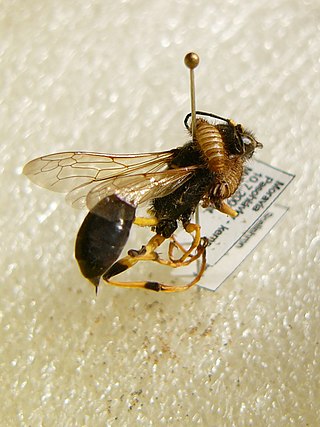
A pest is any organism harmful to humans or human concerns. The term is particularly used for creatures that damage crops, livestock, and forestry or cause a nuisance to people, especially in their homes. Humans have modified the environment for their own purposes and are intolerant of other creatures occupying the same space when their activities impact adversely on human objectives. Thus, an elephant is unobjectionable in its natural habitat but a pest when it tramples crops.

Root-knot nematodes are plant-parasitic nematodes from the genus Meloidogyne. They exist in soil in areas with hot climates or short winters. About 2000 plants worldwide are susceptible to infection by root-knot nematodes and they cause approximately 5% of global crop loss. Root-knot nematode larvae infect plant roots, causing the development of root-knot galls that drain the plant's photosynthate and nutrients. Infection of young plants may be lethal, while infection of mature plants causes decreased yield.
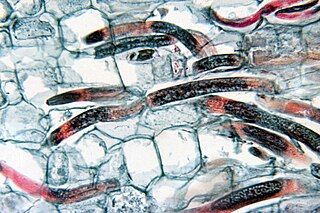
Radopholus similis is a species of nematode known commonly as the burrowing nematode. It is a parasite of plants, and it is a pest of many agricultural crops. It is an especially important pest of bananas, and it can be found on coconut, avocado, coffee, sugarcane, other grasses, and ornamentals. It is a migratory endoparasite of roots, causing lesions that form cankers. Infected plants experience malnutrition.
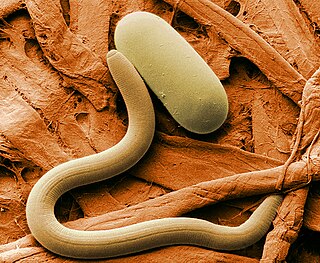
The soybean cyst nematode (SCN), Heterodera glycines, is the most devastating pest to soybean crop yields in the U.S., targeting the roots of soybean and other legume plants. When infection is severe SCNs cause stunting, yellowing, impaired canopy development, and yield loss. The symptoms caused by SCNs can go easily unrecognized by farmers—in some cases there are no warning symptoms before a loss of 40% of the yield. Due to the slight stunting and yellowing, many farmers may mistake these symptoms as environmental problems when in fact they are SCNs. Another symptom of SCNs that may affect farmers' yields is stunted roots with fewer nitrogen-fixing nodules. Due to the fact that soybean cyst nematodes can only move a few centimeters in the soil by themselves, they mostly are spread via tillage or plant transplants. This area of infection will look patchy and nonuniform making diagnosis more difficult for farmers. They can be seen in the roots of summer soybean plants if the roots are taken out very carefully and gently washed with water. The egg masses should be seen as bright white or yellow "pearls" on the roots. The later the roots are pulled the harder it will be to diagnose due to the SCNs female dying and turning a much darker color, forming a "cyst". The best way to know if a field is infected by soybean cyst nematodes is to take a soil sample to a nematologist.
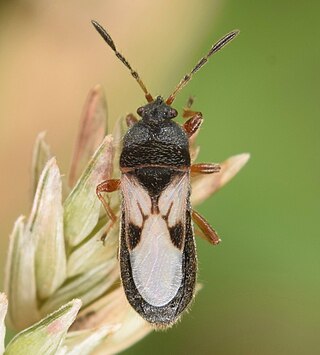
Blissus leucopterus, also known as the true chinch bug, is a small North American insect in the order Hemiptera and family Blissidae. It is the most commonly encountered species of the genus Blissus, which are all known as chinch bugs. A closely related species is B. insularis, the southern chinch bug.
Belonolaimus longicaudatus is a common parasite of grasses and other plant crops and products. It is the most destructive nematode pest of turf grass, and it also attacks a wide range of fruit, vegetable, and fiber crops such as citrus, cotton, ornamentals, and forage. The sting nematode is a migratory ectoparasite of roots. It is well established in many golf courses and presents a problem in turf management. The sting nematode is only present in very sandy soils. It cannot reproduce in heavier or clay soils.

Rotylenchulus reniformis, the reniform nematode, is a species of parasitic nematode of plants with a worldwide distribution in the tropical and subtropical regions.
Paratrichodorus minor is a species of nematode in the family Trichodoridae, the stubby-root nematodes. It occurs in tropical and subtropical regions of the world. It damages plants by feeding on the roots and it is a vector of plant viruses. It is a pest of some agricultural crops.

Aphelenchoides ritzemabosi is a plant pathogenic nematode. It was first scientifically described in 1890 in England. This nematode has a wide host range. Among the most important species affected are Chrysanthemums and strawberries. A. ritzemabosi is a migratory foliar feeding nematode. It can feed both ectoparasitically and endoparasitically, with the later causing the most significant damage. When adequate moisture is present, this nematode enters the leaves and feeds from inside the tissue. Typical damage is characterized by necrotic zones between the veins of the leaves. Its lifecycle is short; only ten days from egg to mature adult. A single female can lay as many as 3,500 eggs. This pest can be difficult to control. Host plant resistance, hot water treatments, and predatory mites are recommended.
Pratylenchus brachyurus is a plant parasitic nematode.
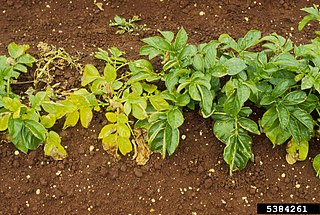
Globodera pallida is a species of nematode in the family Heteroderidae. It is well known as a plant pathogen, especially of potatoes. It is "one of the most economically important plant parasitic nematodes," causing major crop losses, and is a model organism used to study the biology of cyst nematodes. Its common names include potato cyst nematode, white potato cyst nematode, pale potato cyst nematode, potato root eelworm, golden nematode, and pale cyst nematode.
Xiphinema americanum, the American dagger nematode, is a species of plant pathogenic nematodes. It is one of many species that belongs to the genus Xiphinema. It was first described by N. A. Cobb in 1913, who found it on both sides of the United States on the roots of grass, corn, and citrus trees. Not only is Xiphinema americanum known to vector plant viruses, but also X. americanum has been referred to as "the most destructive plant parasitic nematode in America", and one of the four major nematode pests in the Southeastern United States.
Mesocriconema xenoplax is a species of plant parasitic nematodes. Nematodes of this particular species are collectively called ring nematodes.
Hoplolaimus is a genus of nematodes known commonly as lance nematodes. They are parasites of plants, and three species are pests of agricultural crops.

Pratylenchus is a genus of nematodes known commonly as lesion nematodes. They are parasitic on plants and are responsible for root lesion disease on many taxa of host plants in temperate regions around the world. Lesion nematodes are migratory endoparasites that feed and reproduce in the root and move around, unlike the cyst or root-knot nematodes, which may stay in one place. They usually only feed on the cortex of the root. Species are distinguished primarily by the morphology of the stylets.

The nematodesroundworms or eelworms, constitute the phylum Nematoda. They are a diverse animal phylum inhabiting a broad range of environments. Most species are free-living, feeding on microorganisms, but there are many that are parasitic. The parasitic worms (helminths) are the cause of soil-transmitted helminthiases.
Helicotylenchus is a genus of nematodes in the family Hoplolaimidae. They are known generally as spiral nematodes. They are found worldwide because they can live and survive in a wide range of habitats. They are among the most common parasitic nematodes of plants; found in corn, bananas, grass, soybeans.
Heterodera zeae, the corn cyst nematode (CCN), is a plant parasitic nematode that feeds on Zea mays (maize/corn). The CCN has a limited economic impact worldwide due to its high soil temperature requirements.
Dolichodorus is a genus of nematodes known commonly as awl nematodes. They are distributed worldwide. They are ectoparasites of plant roots, and some are pests of agricultural crops.









